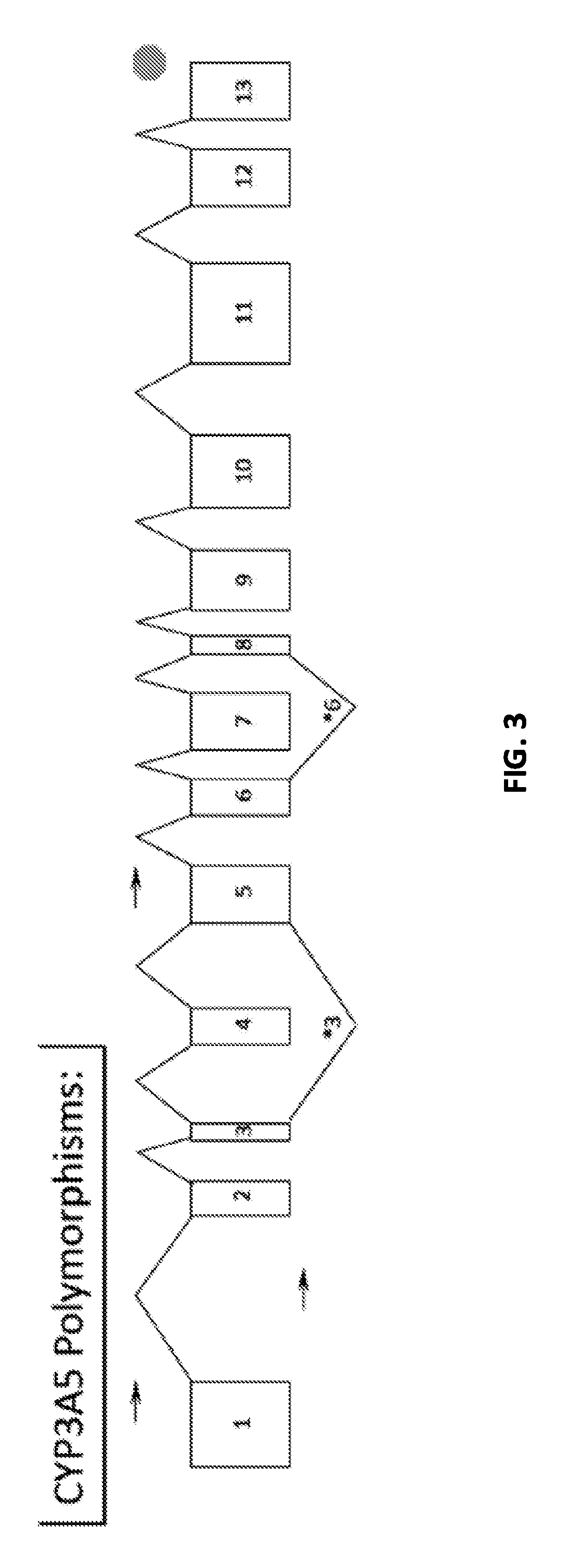Renal selective inhibition of cytochrome P450 3A5
a cytochrome p450 and cytochrome cyp3a5 technology, applied in the field of antisense oligomer compounds, can solve the problems of poor control rate of systolic hypertension in three quarters of adults with cardiovascular disease (cvd) comorbidities, increased risk of stroke, and accumulation of cytochrome cyp3a5 enzymes in the kidney, so as to reduce the expression of cytochrome cyp3
- Summary
- Abstract
- Description
- Claims
- Application Information
AI Technical Summary
Benefits of technology
Problems solved by technology
Method used
Image
Examples
example 2
CYP3A5 Sequence-specific Inhibition but not CYP3A4 by SEQ ID NO: 1
[0092]Antisense oligomers are shown in Table 1. The oligomer CYP3A5-AUG (SEQ ID NO: 1) is a 23-mer having 100% complementarity to the region containing the AUG start codon in the human CYP3A5 mRNA. Referring now to FIG. 12, synthetic oligomers having SEQ ID NO: 1, were prepared as both PSO, purchased from Integrated DNA Technologies (Coralville, Iowa), and as PMO, purchased from GeneTools (Philomath, Oreg.). Caco-2 clone TC7 cells were used because the cells constitutively express CYP3A5 and not CYP3A4, which is key to the experimental design in that the metabolism of the substrate can only come from CYP3A5, the target of the oligomers. A quantity of approximately 20,000 / well of caco-2 clone TC7 cells were grown in a white-walled, 96-well cell culture plate, purchased from Greiner Bio-One. A dose-range of oligomers of 0.3-30 micromoles (μM) was added to the media to establish a dose-response relationship for inhibitio...
example 3
Oligomers Targeting Intron 3 Influence Expression of CYP3A5*3
[0093]HEK293 cells were exposed to oligomer CYP3A5*3 (SEQ ID NO: 3) which was designed to bind to the cryptic splice acceptor site in intron 3 of CYP3A5*3 and prevent splicing at that site resulting in correct splicing to the splice acceptor of exon 4. Exposure to this oligomer in HEK293 cells for 48 hours led to expression of CYP3A5 mRNA and protein confirming the proposed action of this 6986A>G mutation as an alternate splice acceptor site. Further, addition of LiCl to HEK293 cells exposed to CYP3A5*3 oligomer prevented the mRNA expression confirming the location of the G4 structure near this SNP.
[0094]Referring now to FIG. 13, exposure of the HEK293 cells to the oligomer CYP3A5 G4 disrupter (SEQ ID NO: 4), which is designed to hybridize to the intron sequence involved in the formation of the G4 structure, do not express CYP3A5 mRNA or protein. Co-administration of KCl to HEK293 cells with the CYP3A5 G4 disrupter prevent...
example 4
Oligomers Targeting Exon 4 Manipulate Expression of CYP3A5*3.
[0095]Referring now to FIG. 14, the antisense oligomers identified as CYP3A5dex4(−3,19) (SEQ ID NO: 5), CYP3A5dex4(−9,16) (SEQ ID NO: 6), CYP3A5dex4(−17,5) (SEQ ID NO: 7), and CYP3A5dex4(+94,118) (SEQ ID NO: 7) are 100% complementary to the human CYP3A5 exon 4 region in the pre-mRNA and were designed to induce exclusion of exon 4. The alignment of the oligomers with Exon 4 is indicated in FIG. 14A. FIG. 14B shows a paradoxical inclusion of exon 4 in the presence of CYP3A5dex4(−3,19) (SEQ ID NO: 5), CYP3A5dex4(−9,16) (SEQ ID NO: 6), CYP3A5dex4(−17,5) (SEQ ID NO: 7), and CYP3A5dex4(+94,118) (SEQ ID NO: 8) oligomers, which are thought to be the result of the oligomer masking the exon junctional complex (EJC) and thus preventing NMD in the CYP3A5*3 transcript and the most efficient NMD blocker is CYP3A5dex4(−3,19) (SEQ ID NO: 5); FIG. 14C confirms an increase in CYP3A5 transcript copy number using quantitative PCR again indica...
PUM
| Property | Measurement | Unit |
|---|---|---|
| diastolic blood pressure | aaaaa | aaaaa |
| diastolic blood pressure | aaaaa | aaaaa |
| blood pressure | aaaaa | aaaaa |
Abstract
Description
Claims
Application Information
 Login to View More
Login to View More - R&D
- Intellectual Property
- Life Sciences
- Materials
- Tech Scout
- Unparalleled Data Quality
- Higher Quality Content
- 60% Fewer Hallucinations
Browse by: Latest US Patents, China's latest patents, Technical Efficacy Thesaurus, Application Domain, Technology Topic, Popular Technical Reports.
© 2025 PatSnap. All rights reserved.Legal|Privacy policy|Modern Slavery Act Transparency Statement|Sitemap|About US| Contact US: help@patsnap.com



